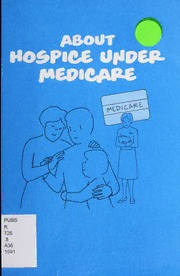
About hospice under Medicare PDF
Preview About hospice under Medicare
ABOUT rr PUBS ••J:;!J!><^3.. Harylenci 21244 WHAT id It'5 a dpeeial way of earing for people wi-lii terminal i\\ne&6e& and tKeir -fannilie^. Hodpiee empKa^i^ed quality of life/ ASCRIPTOGRAPHICBOOKLETbyCHANNINGL.BETECO.INC..SouthDeerfield. MA01373U.S.A. © 1990All rightsreserved. Lithographedin U.S.A. 1991 Edition 37796B-11-90 Toreorderphone800-628-7733and reduestbookletnumber37796. Because liospiee care offers benefits that o-riier types of health care may hot. For example: FAMIty eoNTRot. INVOI.V6MENT in making in the care of a for patients and decisions about loved one, since their families, care. Patients most often care such as pain and their is provided in management, families are the home. grief counseling deeply involved and volunteer in decisions support. about care. If you receive Medicare benefits^ youVe entitled to hospice care, team more • • * 3 It^s de&igned to help tlie person to make the most of each hour and each day of remaining life. It heJps: PeoPL^ THe PKASe IH OF AH iNeupABte iu.Nes5 Hospice care is designed to help the person to: UVe AT MOMS; or in the most comfortable setting for as long as pos- sible. If no caregiver is available at home, the hos- pice team can help arrange an alternative setting where people's needs can most appropriately be met. STAY AS Aenve AS POSSIBLE ~ with hospice help, people can do as much as their condition allows. e>U>PCSS AHP AeeepT FeeuMes of fear, anger, confusion and pain. The hospice staff can give support and understanding. FAMiues Hospice can help the family to: CAt^ fOfL THEIfL tovep ONE by learning to provide many types of care - whatever they're comfortable with and able to give. PPAenCAL TASKS; such as completing financial applications, running errands, preparing special meals, and getting medications, supplies and equipment. P6At WITH THe STRESS of an approaching loss, and the many demands of giving care. ppovipe SUPPORT to each other in a time of crisis. HOSPiee CARS H6tPS peopte Feet at peAee as the end of life's journey approaches. It creates a loving environment where family members can say goodbye. UAm* ABOUT Mospiee It's too much for one person to meet all the needs of a seriously ill person. Hospice uses a team approach that includes: • family • nurses • social workers • physicians • clergy • volunteers. People with many different skills work together to plan and coordinate care. HUP IS AUl^PCfS AVAItABte Family or friends providing care in the home can call for help - and a hospice team member will respond promptly, 24 hours a day, 7 days a week. A member of the hospice team will come to the patient's home whenever needed. The hospice team can arrange for a transfer to another setting if needed. MepieARE eovep6 many seRviees • nursing services on an intermittent basis • pliysician services • drugs, including outpatient drugs for pain relief and symptom management • physical therapy, occupational therapy, and speech- language pathology • home health aide and homemaker services • medical supplies and appliances • short-term inpatient care, including respite care • medical social services WHO'S eLi6iBi.e FOIL Hospiee Anyone covered by A Part of Medicare. THe MepicApe H05Piee BenepiT pays* for care related to ter- minal Illnesses when all 3 of these conditions are met: 1. The patient's physician and the hospice medical director certify that a patient is ter- minally ill (a life expectancy of 6 months or less). 2. The patient chooses to receive care from a hospice instead of standard Medicare benefits. 3. Care is provided by a hospice program certified by Medicare. *A patient may be asked to pay: 5% • of the cost of outpatient drugs or $5 for each prescription, whichever is less 5% • of the Medicare rate for respite care. MCPieApe PAYS eove^ep costs for: • two 90-day periods • one additional 30-day period • an unlimited extension, if the patient is recertified as terminally ill. The patient may stop hospice care at any time and return to cure-oriented care. Any remaining days in a benefit period are forfeited once hospice care is stopped. THe MepicApe Hospiee seHefiT Poes HOT PAY for treatments or services unrelated to the terminal ill- ness. Any attending physician charges would continue to be reimbursed in part through Medicare Part B coverage. However, the standard Medicare benefit program still helps pay covered costs necessary to treat an unrelated condition. HOW TO cHoose A Hospice Find out all you ean about MeJieare-eertifie«l liospiee pro^rannd in your area. TAU<- WITH: • your physician • a hospital discharge planner or social worker • your state or local health department • your state hospice organization. CAli. THe Hospiee (1-800-658-8898). You can also write to: The National Hospice Organization 1901 North Moore St. Suite 901 Arlington, VA 22209. lO
